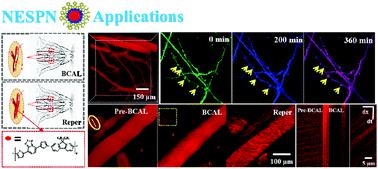当前位置:
X-MOL 学术
›
Biomater. Sci.
›
论文详情
Our official English website, www.x-mol.net, welcomes your
feedback! (Note: you will need to create a separate account there.)
NIR-emitting semiconducting polymer nanoparticles for in vivo two-photon vascular imaging.
Biomaterials Science ( IF 5.8 ) Pub Date : 2020-05-06 , DOI: 10.1039/c9bm02063b Xiao-Ting Gong 1 , Wenguang Xie 2 , Jing-Jing Cao 1 , Shengxiang Zhang 2 , Kanyi Pu 3 , Hao-Li Zhang 4
Biomaterials Science ( IF 5.8 ) Pub Date : 2020-05-06 , DOI: 10.1039/c9bm02063b Xiao-Ting Gong 1 , Wenguang Xie 2 , Jing-Jing Cao 1 , Shengxiang Zhang 2 , Kanyi Pu 3 , Hao-Li Zhang 4
Affiliation

|
Two-photon fluorescence (TPF) imaging holds great promise for real-time monitoring of cerebral ischemia-reperfusion injury, which is important for the clinical diagnosis of stroke. However, biocompatible and photostable NIR-emitting probes for TPF imaging of ischemic stroke are lacking. Herein, we report the first NIR-emitting TPF probe (named NESPN) prepared using semiconducting polymers for TPF imaging of cerebral ischemia. By virtue of its excellent biocompatibility with the nervous system and bright fluorescence NIR emission, NESPN enables the real-time imaging of mouse brain vasculature with micrometer-scale spatial resolution, realizing clear visualization of ultrafine capillaries (∼3.16 μm). Moreover, NESPN can be utilized in the dynamic monitoring of cerebral blood flow velocity. Microangiography using NESPN was successfully used to indicate the openness of the penumbra area in the mouse brain stroke model. More importantly, this technique allows us to continuously monitor the whole process of ischemic stroke and subsequent reperfusion. This work provides a new and versatile tool for vascular research and diagnosis of vascular diseases.
中文翻译:

用于体内双光子血管成像的NIR发射半导体纳米粒子。
两光子荧光(TPF)成像技术对脑缺血再灌注损伤的实时监测具有广阔的前景,这对中风的临床诊断具有重要意义。但是,缺乏用于缺血性中风的TPF成像的生物相容性和光稳定性NIR发射探针。在此,我们报告了使用半导体聚合物为脑缺血的TPF成像制备的第一个发射NIR的TPF探针(名为NESPN)。凭借其与神经系统的出色生物相容性和明亮的NIR荧光发射,NESPN能够以微米级的空间分辨率对小鼠脑血管进行实时成像,从而实现超细毛细血管(约3.16μm)的清晰可视化。此外,NESPN可用于动态监测脑血流速度。使用NESPN的微血管造影已成功用于指示小鼠脑卒中模型中半影区的开放性。更重要的是,这项技术使我们能够连续监测缺血性中风和随后的再灌注的整个过程。这项工作为血管研究和诊断血管疾病提供了一种新的通用工具。
更新日期:2020-03-20
中文翻译:

用于体内双光子血管成像的NIR发射半导体纳米粒子。
两光子荧光(TPF)成像技术对脑缺血再灌注损伤的实时监测具有广阔的前景,这对中风的临床诊断具有重要意义。但是,缺乏用于缺血性中风的TPF成像的生物相容性和光稳定性NIR发射探针。在此,我们报告了使用半导体聚合物为脑缺血的TPF成像制备的第一个发射NIR的TPF探针(名为NESPN)。凭借其与神经系统的出色生物相容性和明亮的NIR荧光发射,NESPN能够以微米级的空间分辨率对小鼠脑血管进行实时成像,从而实现超细毛细血管(约3.16μm)的清晰可视化。此外,NESPN可用于动态监测脑血流速度。使用NESPN的微血管造影已成功用于指示小鼠脑卒中模型中半影区的开放性。更重要的是,这项技术使我们能够连续监测缺血性中风和随后的再灌注的整个过程。这项工作为血管研究和诊断血管疾病提供了一种新的通用工具。











































 京公网安备 11010802027423号
京公网安备 11010802027423号